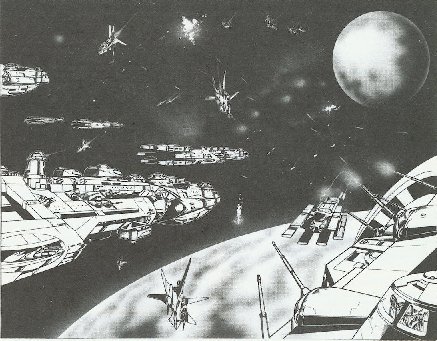|
|
|
 |
About the SFC |  |
| "INCOMING !!!" Pirate-owned PF-5 Shadow Stars wreaking havoc with Strike Force NOVA >>> |
 |
|
About the Star Fighter Corps Following the second Sathar War, UPF tacticans deduced that the star fighters were becoming a useless form of engagement. Typical practice at the time was to offer these jobs to low ranking unskilled pilots to give them time and experience to ultimately move up to larger fleet ships with more attractive mortality rates, such as the Assault Scout. The typical combat patterns indicated that larger ships tended to ignore the fighters, whose unskilled pilots had a difficult time hitting their intended targets and quickly depleted their limited supply of rockets, assuming they survived long enough to launch all three birds. More often than not the bigger enemy ships ended up treating them as pesky flies that could be swatted away at their convenience as opportunity presented itself. Mercenary Starbase, a privately funded organization backed by Star Law and Pan Galactic, began to initiate a competitive Star Fighter program, upgrading the basic fighter design as well as demanding new fighter designs along with offering special training for the fighter pilots. The new designs feature an auto-eject module (AEM) function where the computer's stress analysis programs determine when the hull is compromised, giving the pilots a good chance of survival if the ship is destroyed. Taking the lethality out of the equation started the new romance with these swift and soon to be deadly craft. With aggressive training, star fighter squadrons soon became a force to be reckoned with. They proved themselves time and again, and now it isn't too uncommon for pilots to stick around much longer despite being qualified to fly larger craft such as Frigates, Destroyers, or even Cruisers. Now the effectiveness of these new fighter squadrons is slowly taking center stage to the Assault Scout in the role of combat and warfare. A squadron (six) of these new smaller, faster, and deadlier craft manned by skilled operators can now overwhelm even the big cruisers with sheer speed and accuracy. When combined with the Assault Scouts, planetary militias no longer have to depend on an insignificant sized fleet of larger ships or the inability for spacefleet vessels to arrive in a timely manner during emergencies to protect their worlds. The Star Fighter Corps, founded shortly after the MS training program was established, is a tightly knit operation. Crews of fighter craft enjoy good pay and benefits packages as well as a sense of belonging in an organization that falls under both the local Planetary Militas as well as Spacefleet, but loosely attached to both at the same time. These star fighters and their crews can be easily transferred from location to location as the need arises, be it an individual pilot or an entire squadron of craft and their support crews. Since the star fighters are easily transported, via an available carrier or UPF Freighters, the SFC is an "on call" group that can be quickly dispatched anywhere with relative ease.
As a result, fighter pilots and crews can find themselves working under Planetary Militia Defensive Fighter Squadrons and UPF Tactical Fighter Squadrons alike, and their rank and pay is easily transferable between the two. In other words, one month a fighter pilot, crew, and craft might be serving under a local Militia, and the next month could be spent aboard a UPF Assault Carrier. The following month one or more individuals could be transferred elsewhere, even to new and different fighter craft, all the while following orders under whichever command they are transferred to. The Star Fighter Corps is a very flexible but tightly knit outfit. While the pilots are the backbone of the Corps, technicians and Engineers are always in demand as well on the upkeep end of these fabulous spacecraft. Anyone with a technical skills that can pass local UPF or Star Law background checks will have no trouble finding work within the Star Fighter Corps, and a fine Starship Engineering program is also available at the same Pilot Training Facilities where technicians can learn the fundamentals of Engineering too, although their training is half a year followed by recieving LVL:0 Starship Engineering skill and another half year tour of duty.
As an additional motive, star fighter crews with good service records have little trouble finding work following completion of their tour of duty. Some stick around and go as far as they can within the corps, while others find transfer into a local Militia or Spacefleet with little difficulty, granting them opportunities to find work aboard Assault Scouts, Frigates, or Destroyers. More Info about Star Fighters The original fighter craft were small, fast, and maneuverable, all traits that carry over to modern star fighters. Certain corners were cut to keep costs down initially, as it was predicted that many craft would not return. One such item is life support, many fighters required their pilots to don vac suits to operate the craft, and that provided 20 hours of time unless any back up LS units were stowed aboard. Jump governors were mandated as well, to prevent a craft from accelerating up to jump velocity, since the pilots wouldn't have enough life support for such a journey. Hence many fighter craft will be listed with sub-atomic or sub-ion drives, indicating said jump governors are installed. Current fighter craft serving under the SFC are mandated to utilize AEM (Auto Eject Modules) technology, where stress sensors and the damage control programs determine when a ship is breaking apart to eject the pilot safely. Survival rates are pretty good as a result, allowing unfortunate but skilled pilots to fly again. Newer fighter craft are appearing with limited life support capability as well, so pilots aren't required to wear the cumbersome pressure suits. As a result, modern star fighters tend to be more pricy but the advantages are well worth the additional investments.
Links to Other Sites |
|